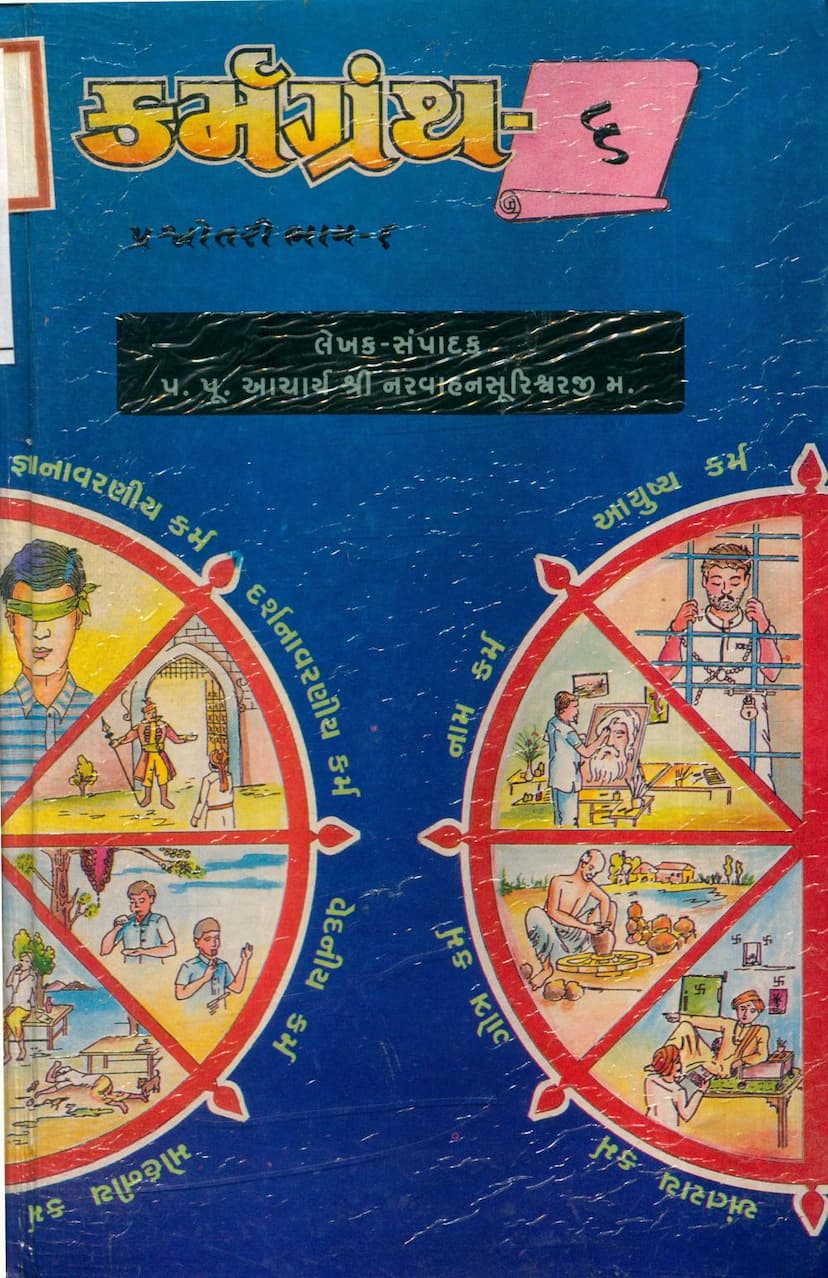Karmgranth 6 Prashnottari Part 06
Added to library: September 2, 2025

Summary
Here's a comprehensive summary of the Jain text "Karmgranth 6 Prashnottari Part 06" by Narvahanvijay, based on the provided text:
Book Title: Karmgranth 6 Prashnottari Part 06 (કર્મ ગ્રંથ-૬, ભાગ-૬) Author/Editor: Acharya Shri Narvahansurishwarji M. Publisher: Padarth Darshan Trust, Ahmedabad Publication Year: 1996 CE / 2052 VS
Overall Purpose: This book is the sixth part of the sixth volume of the "Karmgranth Prashnottari" series. It is a question-and-answer text that delves deeply into the intricacies of Jain karmic theory, specifically focusing on the bandh (bondage), uday (manifestation), and satta (dormancy) of the eight types of karma across the fourteen gunasthanas (stages of spiritual development). The text also analyzes the various bhangas (forms or states) and samved bhangas (manifestation of feelings) associated with these karmas.
Key Content and Structure:
The book is structured as a series of questions and answers, systematically explaining the behavior of different karmas at each guna'sthana. The core of the text covers:
- Jnanavarniya and Antaray Karma: The text begins by detailing the bhangas (states) of bondage, manifestation, and dormancy for knowledge-obstructing (Jnanavarniya) and obstructive (Antaray) karmas. It specifies that these states exist up to the tenth guna'sthana, with manifestation and dormancy present in the eleventh and twelfth.
- Darshanavarniya Karma: It then elaborates on the samved bhangas of perception-obstructing (Darshanavarniya) karma, outlining the specific number of states and their progression through the first twelve gunasthanas. It includes details for both the kshayopasham (partial destruction/suppression) and kshayik (complete destruction) paths.
- Vedaniya, Ayushya, and Gotra Karma: The text briefly mentions the samved bhangas for feeling-producing (Vedaniya), lifespan (Ayushya), and species-determining (Gotra) karmas. It provides detailed explanations for the number of bhangas for Vedaniya karma across the gunasthanas and then extensively covers the various states for Gotra karma, including its progression from lower to higher gunasthanas and its absence at the ultimate stages.
- Ayushya Karma: A significant portion is dedicated to the Ayushya karma, enumerating the number of bhangas for this karma in each of the first seven gunasthanas, and then further detailing them for the remaining stages. The calculations for these bhangas are presented, considering different life-forms (hell-beings, animals, humans, celestial beings) and the possibility of binding different types of lifespan karma.
- Mohaniya Karma: A substantial part of the book focuses on Mohaniya (delusion-producing) karma. It details:
- Bandhasthanas (Stages of Bondage): The number of bondage stages for Mohaniya karma in each guna'sthana, noting that bondage ceases after the eighth guna'sthana and detailing the five specific stages in the ninth.
- Udayasthanas (Stages of Manifestation): The number and types of manifestation stages for Mohaniya karma in each guna'sthana, from the first to the fourteenth. It explains how different types of samyak darshan (right faith) influence these stages and provides specific examples of manifestation in the fourth and fifth gunasthanas.
- Bhanganu Ke Pramanu (Number of Forms): It delves into the complexity of Mohaniya karma's bhangas by calculating the number of bhangas related to manifestation based on different udayasthanas, padavrund (combination of manifestation and associated states), and chovishi (sets of twenty-four). The text elaborates on these calculations for the first ten gunasthanas.
- Yoga, Upayog, and Leshya: The latter half of the book extends the karmic analysis by incorporating the influence of yoga (activity of mind, speech, and body), upayog (awareness/cognition), and leshya (subtle karmic color) on the karmic bhangas. It systematically calculates the bandhoday sattva bhangas (bondage, manifestation, and dormancy forms) considering these additional factors for each guna'sthana. This section involves extensive numerical calculations and detailed breakdowns for each factor.
- Nam Karma: The book concludes by analyzing the bondage, manifestation, and dormancy states and bhangas of Nam Karma (name-giving karma) across the fourteen gunasthanas. This section, like the Mohaniya karma analysis, involves a vast amount of numerical data and detailed combinatorial calculations.
Key Concepts Discussed:
- Eight Types of Karma (Ashtakarma): Jnanavarniya, Darshanavarniya, Vedaniya, Mohaniya, Ayushya, Gotra, Nam, and Antaray.
- Fourteen Gunasthanas: The stages of spiritual development in Jainism.
- Bandh, Uday, Satta: The processes of karmic bondage, manifestation, and dormancy.
- Bhanga and Samved Bhanga: Different states and the experiential manifestation of karmas.
- Kshayopasham and Kshayik: The partial and complete destruction of karmic matter.
- Yoga, Upayog, Leshya: Factors that influence the manifestation and complexity of karmic states.
- Mathematical and Combinatorial Calculations: The text is heavily laden with detailed calculations to quantify the vast number of possible karmic states and their interactions across different spiritual stages and biological forms.
Significance and Target Audience:
This book is a highly technical and detailed study of Jain karmic theory. It is intended for serious students, scholars, and practitioners of Jainism who wish to understand the profound and complex workings of karma as explained in the Jain scriptures. The sheer volume of numerical data indicates a deep dive into the mathematical aspects of Jain philosophy, requiring a strong foundation in the subject matter.
Overall Impression:
"Karmgranth 6 Prashnottari Part 06" is a rigorous and exhaustive treatise on the subject of karma in Jainism. It meticulously breaks down the karmic processes across all stages of spiritual development, incorporating various influencing factors like yoga, upayog, and leshya. The book serves as a valuable resource for those seeking a comprehensive and numerically detailed understanding of this fundamental Jain doctrine.